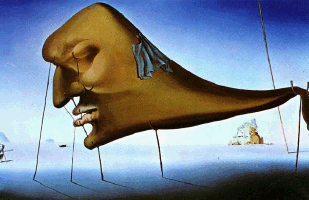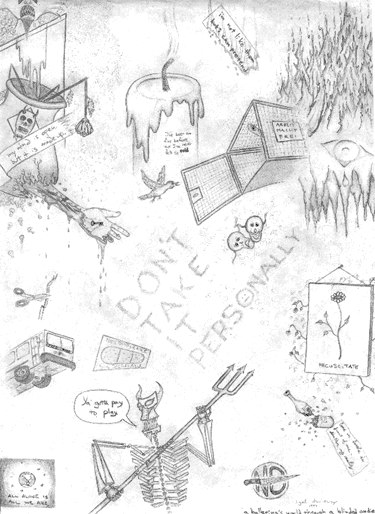Surrealism - Salvador Dalí
Surrealism: 1924-1940
Surrealism grew out of the period between the World Wars, begun by Andre Breton in 1924. He along with Rene Magritte, Max Ernst and very visibly Salvador Dali took off all chokes from art. Their painting style combined all the elements and smashed them together with a demented sense of humor. Typical drawings include: trains coming out of chimneys, melted clocks and spider-giraffes-from-Hell.

"Le Sommeil" by Salvador Dali
Surrealism Lesson / Origins
Surrealism, in many respects, was an offshoot of an earlier art movement known as dada, which was founded during World War I (1914-1918). Disillusioned by the massive destruction and loss of life brought about by the war, the dadaists’ motivations were profoundly political: to ridicule culture, reason, technology, even art. They believed that any faith in humanity's ability to improve itself through art and culture, especially after the unprecedented destruction of the war, was naive and unrealistic. As a result, the dadaists created works using accident, chance, and anything that underscored the irrationality of humanity: for example, making poems out of pieces of newspaper chosen at random, speaking nonsensical syllables out loud, and displaying everyday objects as art. The surrealist program grew out of dada, but it put a more positive spin on dada's essentially negative message.
The surrealists were heavily influenced by Sigmund Freud, the Austrian founder of psychoanalysis. They were especially receptive to his distinction between the ego and the id—that is, between our primal instincts and desires (the id) and our more civilized and rational patterns of behavior (the ego). Since our primal urges and desires frequently run afoul of social expectations, Freud concluded that we repress our real desires into the unconscious part of our minds. For individuals to enjoy psychological health, he felt, they must bring these desires to the awareness of the conscious mind. Freud believed that despite the overwhelming urge to repress desires, the unconscious still reveals itself—particularly when the conscious mind relaxes its hold—in dreams, myths, odd patterns of behavior, slips of the tongue, accidents, and art. In seeking to gain access to the unconscious, the surrealists invented radical new art forms and techniques.
"The movement represented a reaction against what its members saw as the destruction wrought by the "rationalism" that had guided European culture and politics in the past and had culminated in the horrors of World War I. Surrealism was a means of reuniting conscious and unconscious realms of experience so completely that the world of dream and fantasy would be joined by the everyday ration world in an absolute reality, a surreality" (Pioch).
Through using the elements to a maximal advantage, the Surrealists harnessed yet another element, that of the reunited conscious/unconscious into one blinding vision of pure emotion.
"The creative process, so far as we are able to follow it at all, consists in the unconscious activation of an archetypal image and elaborating and shaping the image into the finished work. By giving it shape, the artist translates it into the language of the present and so makes it possible for us to find our way back to the deepest springs of life."
- Carl Jung

"Ballerina's world through a blinded audience's eyes"
by Igal Koshevoy
Surrealism Lesson tasks
Answer this questionnaire about Surrealism:
(All written work should be typed in an ordinary font, size 10 or 12, and double-spaced. )
- What does “surrealism” mean?
- When was the surrealism period of art?
- Who are some of the main proponents of surrealism?
- Where was surrealism prominent?
- How did surrealism develop? (What did it respond to? What events or phenomena helped surrealism come about? What was the main focus of surrealism?)
- Why didn’t surrealism continue as a preeminent style of art?
• Write a "description" paragraph about one work of Surrealistic visual art.
• Remember that writing about includes three types of writing:
- Description
- Interpretation
- Evaluation
• Write a report about Surrealism; write about…
• An artist; or
• An artwork; or
• The surrealism movement’s legacy on twentieth century art; or
• The general history of surrealism.
• List your reference sources in a bibliography and or a "works cited" section.
• Create a surrealistic image.
Use these guidelines:
• 7” x 8.75”
• 300 ppi
• CMYK
• White background
• Consider including an image of yourself in the artwork.
• Print your artwork on photo quality paper.
Surrealism Lesson / Links
You may visit various web sites, including the following, for more information about Surrealism:















